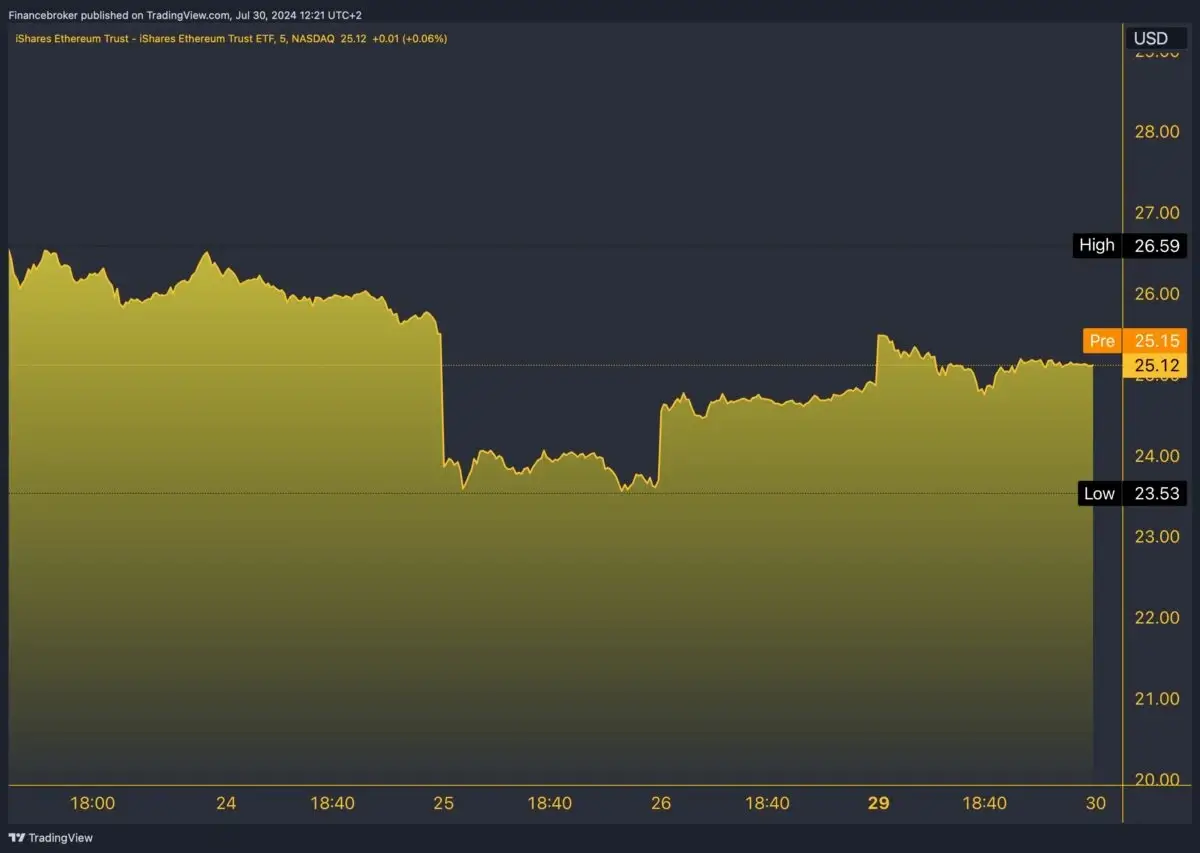Ethereum ETFs: A Strong Start, But Can It Match Bitcoin?
Image Source: Unsplash
Ethereum ETF’s Strong Launch: Can It Outperform Bitcoin?
The debut of Ethereum (ETH) exchange-traded funds (ETFs) has stirred considerable interest in the financial sector. These new investment options provide investors with a straightforward way to invest in Ethereum, one of the leading cryptocurrencies. But what exactly is an Ethereum ETF?
A spot Ethereum ETF collects money from investors to buy Ethereum directly. These funds, managed by investment firms, are traded on traditional stock exchanges, making digital currency trading more accessible and regulated.
The launch of spot Ether exchange-traded funds on July 23 started strong, attracting over $100 million in net inflows on the first trading day.
However, these numbers did not manage to reach Bitcoin’s historic ETF debut in January. Analysts worry that Ether might be less appealing to traditional investors in comparison to Bitcoin.
If Bitcoin funds boosted the underlying asset to new peaks, why wouldn’t Ether experience the same effect? Especially considering that the first week of spot ETH ETF trading has presented mixed results.
At first, Ethereum ETFs secured $107 million in total inflows on Monday. However, Wednesday and Thursday ended with outflows of $133 million and $153 million, according to data from SosoValue. Ether also declined by 4.6% over the week, based on CoinGecko data. Interestingly, this mirrors the initial reaction seen when Bitcoin ETFs were introduced, which also experienced significant price fluctuations and inflows.
Ethereum ETF News: Recent Performance
ETH ETFs launched with impressive initial trading volumes, exceeding analysts’ predictions. According to Bloomberg data, the products accumulated $107 million in net inflows.
BlackRock’s iShares Ethereum Trust ETF (ETHA) took the lead, gathering $266.5 million, followed by Bitwise’s Ethereum ETF (ETHW), which accumulated $204 million. Overall, Ethereum ETFs achieved over $1 billion in trading volume on their debut day.
However, this performance faced challenges due to significant outflows from Grayscale’s Ethereum Trust (ETHE). For instance, this asset saw $484.1 million in outflows.
Despite these outflows, the positive net inflows for the new ETFs marked a strong start. Nonetheless, they remain modest compared to the inflows experienced by Bitcoin ETFs.
Bitcoin ETFs set a high standard, drawing in approximately $12.7 billion within their first three months. In contrast, Ethereum ETFs should accumulate between $1 billion and $2 billion in total assets under management (AUM) over the same period. This estimate equates to about 10% to 15% of the amount Bitcoin ETFs garnered in a similar timeframe.
Adrian Fritz, head of research at 21Shares, pointed out that the Bitcoin Spot ETF achieved unprecedented success, becoming the most successful ETF launch in financial history. He explained that Bitcoin’s narrative as an emerging store of value is straightforward and easily understood by investors.
On the other hand, Ethereum’s value proposition is more intricate. It may require additional time and educational efforts to reach comparable levels of acceptance.
(Click on image to enlarge)
ETHA 5-Day Chart
SEC’s Approval: A News Milestone in Asset’s Journey
On Monday evening, the Securities and Exchange Commission (SEC) approved the introduction of spot exchange-traded funds (ETFs). The official Ethereum ETF approval date was set for Tuesday, July 23.
The SEC authorized eight Ethereum ETFs issued by different entities:
- Grayscale Ethereum Mini Trust (ETH)
- Franklin (EZET)
- VanEck (ETHV)
- Bitwise (ETHW)
- 21Shares Core (CETH)
- Fidelity Ethereum Fund (FETH)
- BlackRock’s iShares Ethereum Trust (ETHA)
- Invesco Galaxy (QETH)
Furthermore, the SEC has also approved Grayscale’s request to convert its Grayscale Ethereum Trust (ETHE) into a spot ETF, according to Bloomberg.
Coincidentally, Ethereum ETFs launched during a tumultuous period in the financial markets. On July 23, both the Nasdaq and S&P 500 saw their largest drops since late 2022. At the time, the Nasdaq plummeted 3.6%, and the S&P 500 declined 2.1% due to disappointing earnings reports from Alphabet (GOOG) and Tesla (TSLA). Meanwhile, Bitcoin held steady at around $66,000. Nonetheless, Ethereum’s price dropped to $3,300, marking nearly a 4% decrease over 24 hours.
Despite the asset’s rocky road, early trading data reveals notable institutional interest in Ethereum ETFs. Armour highlighted significant trading volumes on the first day, which often signals substantial institutional activity. This early interest from institutional investors is crucial for the ongoing success of Ethereum ETFs.
The introduction of Ethereum ETFs marks a key development in the cryptocurrency sector, thereby giving traditional investors a new path to invest in Ether. While the initial results are promising, it’s unclear whether Ethereum will attract the same level of institutional interest as Bitcoin.
At this point, the launch of Ethereum ETFs signifies an important step forward. However, the path to widespread integration is still very far from over.
More By This Author:
Ripple And Tron: Tron Is On The Defensive And Under Pressure
Market Trends Shift: Anticipating The Fed’s Impact On Stocks
Bitcoin Is On Track To Return To $70,000 This Week
Disclosure: Finance Brokerage and its workforce cannot, and do not, absolute warrant the accuracy, relevancy, reliability, consistency, and completeness of any information and materials in the ...
more




